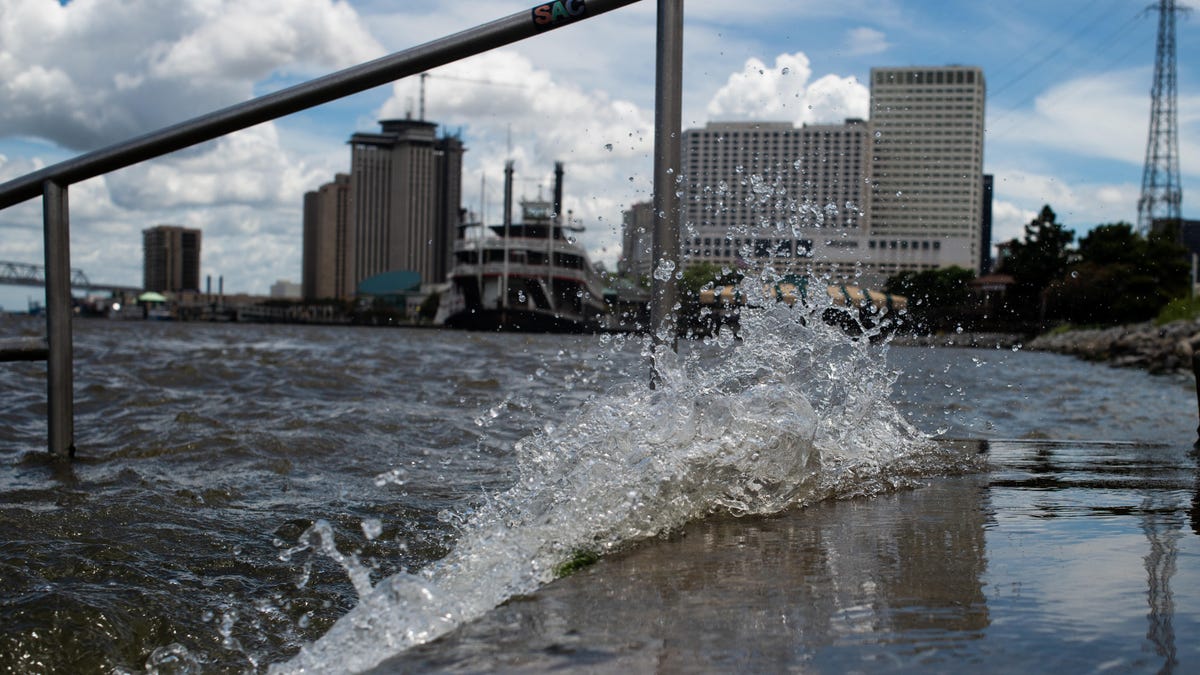Tropical Storm Barry: How Verizon, AT&T, T-Mobile, Sprint prep for mobile coverage in face of disasters
The big four carriers are battening the LTE hatches ahead of the incoming potential hurricane.

The Mississippi River splashes against the levees in New Orleans.
The first major tropical storm from the Gulf this season is on its way, and all four major mobile carriers are knee-deep in preparations to ensure their networks stay as solid as possible. Verizon , AT&T , T-Mobile and Sprint have each detailed the work they've put into preparing for Tropical Storm Barry this weekend.
Tropical Storm Barry is approaching the Louisiana coastline as of Friday afternoon, with almost 10,000 people already told to evacuate their homes. It's possible that it'll make landfall as a hurricane on Saturday, the National Hurricane Center told CNET sister site CBS News, with 10 to 20 inches of rainfall expected in Louisiana and southwest Mississippi.
Kyle Malady, Verizon CTO, said "running to a crisis" to help communities by ensuring that consumers, first responders, public safety teams and enterprises remain connected is fundamental to his carrier. "We have been preparing our network and are ready to support those in the path of Tropical Storm Barry," Malady said.
Some of the work Verizon has done includes prepping surveillance drones; setting up storm command centers in network facilities able to withstand category 5 winds; inspecting backup generators, fiber rings and HVAC systems at its cell sites; organizing portable emergency equipment to be deployed quickly to restore any damaged connections; prearranging fuel deliveries so tankers are in place to quickly respond if power is lost; and adding a swath of portable cell sites with secure, dedicated satellite links.
Verizon is also working with first responders through the Verizon Response team to "mobilize charging stations, devices, special equipment, emergency vehicles and more to support local, state and federal agencies across the US," Malady said.
AT&T's Tropical Storm Barry preparations have involved topping off fuel generators, testing its high-capacity backup batteries located at cell sites, protecting physical network facilities from the potential of flooding, storing network recovery and emergency response equipment in strategic locations for fast deployment and of course ensuring FirstNet has dedicated deployable network assets for public safety agencies ready to go.
"We have installed more generators at critical cell towers and switching facilities, and moved electronics essential to network operations above expected flood levels," AT&T said. "In addition to a number of fixed generators located throughout the state, we have nearly 700 portable generators in the Southeast region that can be deployed to support our facilities if needed."
Some of AT&T's storm-ready tech includes amphibious all-terrain vehicles (ATVs), mobile cell sites like cells on wheels (COWs), cells on light trucks (COLTs) and flying COWs, emergency comms vehicles, hazmat supplies, tech trailers and even a base camp setup that comes complete with nurses, meals, laundry facilities, bathrooms, kitchens and sleeping tents. Its also providing unlimited talk, text and data to customers across 22 parishes from July 12 through July 18.
T-Mobile said its ready for the 2019 storm season thanks to having COWs, COLTs, temporary backhaul solutions, refueling services, portable generators and relief trucks placed as close as possible to storm zones. T-Mobile also sends engineers, field techs and community relief teams into impacted areas, and uses its network operation centers (NOCs) to monitor network demand and manage traffic.
T-Mobile is also advising customers to send texts rather than make calls during the storm, because text messages are more likely to get through during congested periods. "Keep calls to a minimum and as short as possible," T-Mobile said. "This helps reduce the load on our network so others can get through."
Lastly, Sprint says its emergency response, disaster recovery and network teams have begun storm prep, with the carrier ready with portable generators, topped-up fixed generators, additional fueling resources and more field techs and equipment being brought into the central Louisiana-upper Texas area.
"Additionally, Sprint Emergency Response Team (ERT) is ready to rapidly deploy temporary cellular and broadband (internet access) solutions through mobile satellite infrastructure," Sprint said.
Sprint has also waived text, call and data overage fees for multiple ZIP codes in Louisiana ahead of the storm hitting the state.
Originally published July 12, 2:32 p.m. PT.
Update, 4:42 p.m.: Includes info on Sprint waiving text, call, data fees; Update, 6:00 p.m.: Includes info on AT&T unlimited talk, text, data

